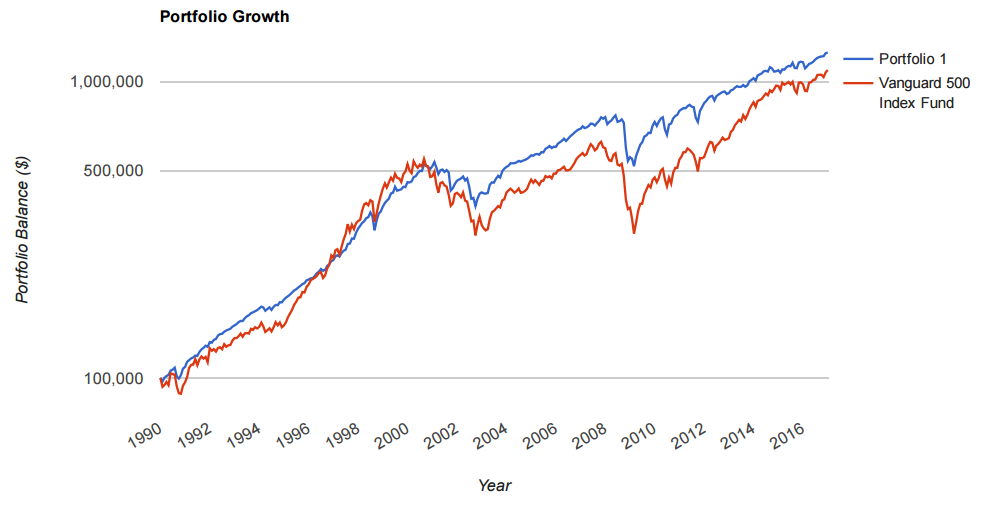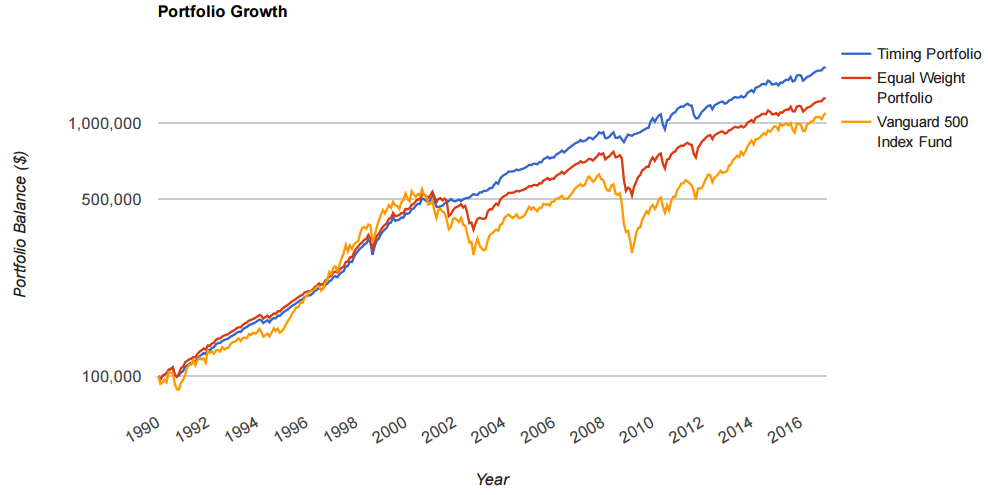
The CBOE PUT write index has caught a lot of attention in recent years, as it historically has produced higher risk-adjusted and absolute returns than the underlying S&P 500 index. Risk adjusted returns take into account both returns and volatility. CBOE describes the index as following:
"The CBOE S&P 500® PutWrite Index (ticker symbol “PUT”) tracks the value of a passive investment strategy (“CBOE S&P 500 Collateralized Put Strategy”) which consists of overlaying S&P 500 (SPM) short put options over a money market account invested in one- and three-months Treasury bills. The SPX puts are struck at-the-money and are sold on a monthly basis, usually on the 3rd Friday of the month. This is called the “roll date” and it matches the date of S&P 500 option expirations."
Here is the performance of PUT (Portfolio 1) vs. VFINX (Vanguard S&P 500 Index Fund) from 1990-2016:


The most attractive part of PUT vs. VFINX is the improvement in risk-adjusted returns. Both volatility and maximum drawdown were cut by about a third, resulting in a nice increase in Sharpe Ratio. Even the most passive investors could benefit from this approach as the PUT selling strategy is now available in an ETF structure from Wisdom Tree. More active investors that follow our Steady Options content may be interested in replicating the PUT selling strategy themselves, saving themselves the 0.38% management fee. In addition to saving on management fees, an active investor with a creative mind can potentially further increase potential returns by keeping collateral in something other than T-bills.
Momentum
What if we add a trend-following, or "time-series momentum" overlay to PUT? We already know that it has been peer reviewed and validated out of sample on multiple underlyings, so why would PUT be any different? Answer: It's not.
Below is the performance of all three: VFINX, PUT (Equal Weight Portfolio), and PUT with a 12 month time series momentum filter where we are invested in PUT when its rolling 12 month excess return is positive, otherwise VBMFX (Timing Portfolio). The timing portfolio reallocation period is monthly.


All charts and statistics were custom generated at www.portfoliovisualizer.com.
As expected, adding time-series momentum cuts off a substantial part of the left-tail of returns. This benefit can't be emphasized enough in the real world of human emotion. Sophisticated traders and investors like those following all of our content at Steady Options could benefit from this approach as part of their long-term portfolio. In our firm, we already utilize a variation of this strategy for our clients.
What Is SteadyOptions?
Full Trading Plan
Complete Portfolio Approach
Diversified Options Strategies
Exclusive Community Forum
Steady And Consistent Gains
High Quality Education
Risk Management, Portfolio Size
Performance based on real fills
Non-directional Options Strategies
10-15 trade Ideas Per Month
Targets 5-7% Monthly Net Return
Recent Articles
Articles
Pricing Models and Volatility Problems
Most traders are aware of the volatility-related problem with the best-known option pricing model, Black-Scholes. The assumption under this model is that volatility remains constant over the entire remaining life of the option.
By Michael C. Thomsett, August 16

- Added byMichael C. Thomsett
- August 16
Option Arbitrage Risks
Options traders dealing in arbitrage might not appreciate the forms of risk they face. The typical arbitrage position is found in synthetic long or short stock. In these positions, the combined options act exactly like the underlying. This creates the arbitrage.
By Michael C. Thomsett, August 7

- Added byMichael C. Thomsett
- August 7
Why Haven't You Started Investing Yet?
You are probably aware that investment opportunities are great for building wealth. Whether you opt for stocks and shares, precious metals, forex trading, or something else besides, you could afford yourself financial freedom. But if you haven't dipped your toes into the world of investing yet, we have to ask ourselves why.
By Kim, August 7

- Added byKim
- August 7
Historical Drawdowns for Global Equity Portfolios
Globally diversified equity portfolios typically hold thousands of stocks across dozens of countries. This degree of diversification minimizes the risk of a single company, country, or sector. Because of this diversification, investors should be cautious about confusing temporary declines with permanent loss of capital like with single stocks.
By Jesse, August 6

- Added byJesse
- August 6
Types of Volatility
Are most options traders aware of five different types of volatility? Probably not. Most only deal with two types, historical and implied. All five types (historical, implied, future, forecast and seasonal), deserve some explanation and study.
By Michael C. Thomsett, August 1

- Added byMichael C. Thomsett
- August 1
The Performance Gap Between Large Growth and Small Value Stocks
Academic research suggests there are differences in expected returns among stocks over the long-term. Small companies with low fundamental valuations (Small Cap Value) have higher expected returns than big companies with high valuations (Large Cap Growth).
By Jesse, July 21

- Added byJesse
- July 21
How New Traders Can Use Trade Psychology To Succeed
People have been trying to figure out just what makes humans tick for hundreds of years. In some respects, we’ve come a long way, in others, we’ve barely scratched the surface. Like it or not, many industries take advantage of this knowledge to influence our behaviour and buying patterns.

- Added byKim
- July 21
A Reliable Reversal Signal
Options traders struggle constantly with the quest for reliable
By Michael C. Thomsett, July 20

- Added byMichael C. Thomsett
- July 20
Premium at Risk
Should options traders consider “premium at risk” when entering strategies? Most traders focus on calculated maximum profit or loss and breakeven price levels. But inefficiencies in option behavior, especially when close to expiration, make these basic calculations limited in value, and at times misleading.
By Michael C. Thomsett, July 13

- Added byMichael C. Thomsett
- July 13
Diversified Leveraged Anchor Performance
In our continued efforts to improve the Anchor strategy, in April of this year we began tracking a Diversified Leveraged Anchor strategy, under the theory that, over time, a diversified portfolio performs better than an undiversified portfolio in numerous metrics. Not only does overall performance tend to increase, but volatility and drawdowns tend to decrease: